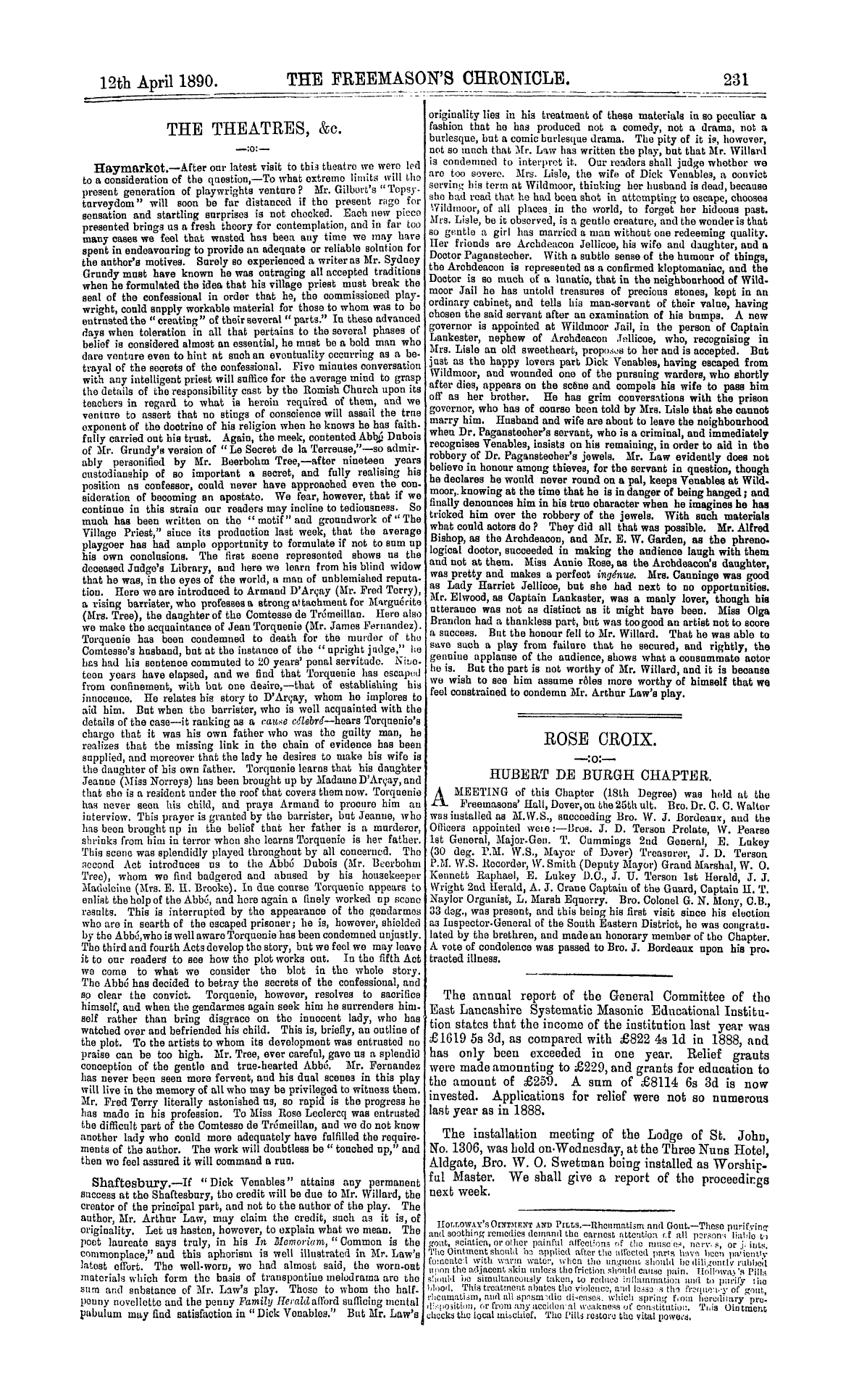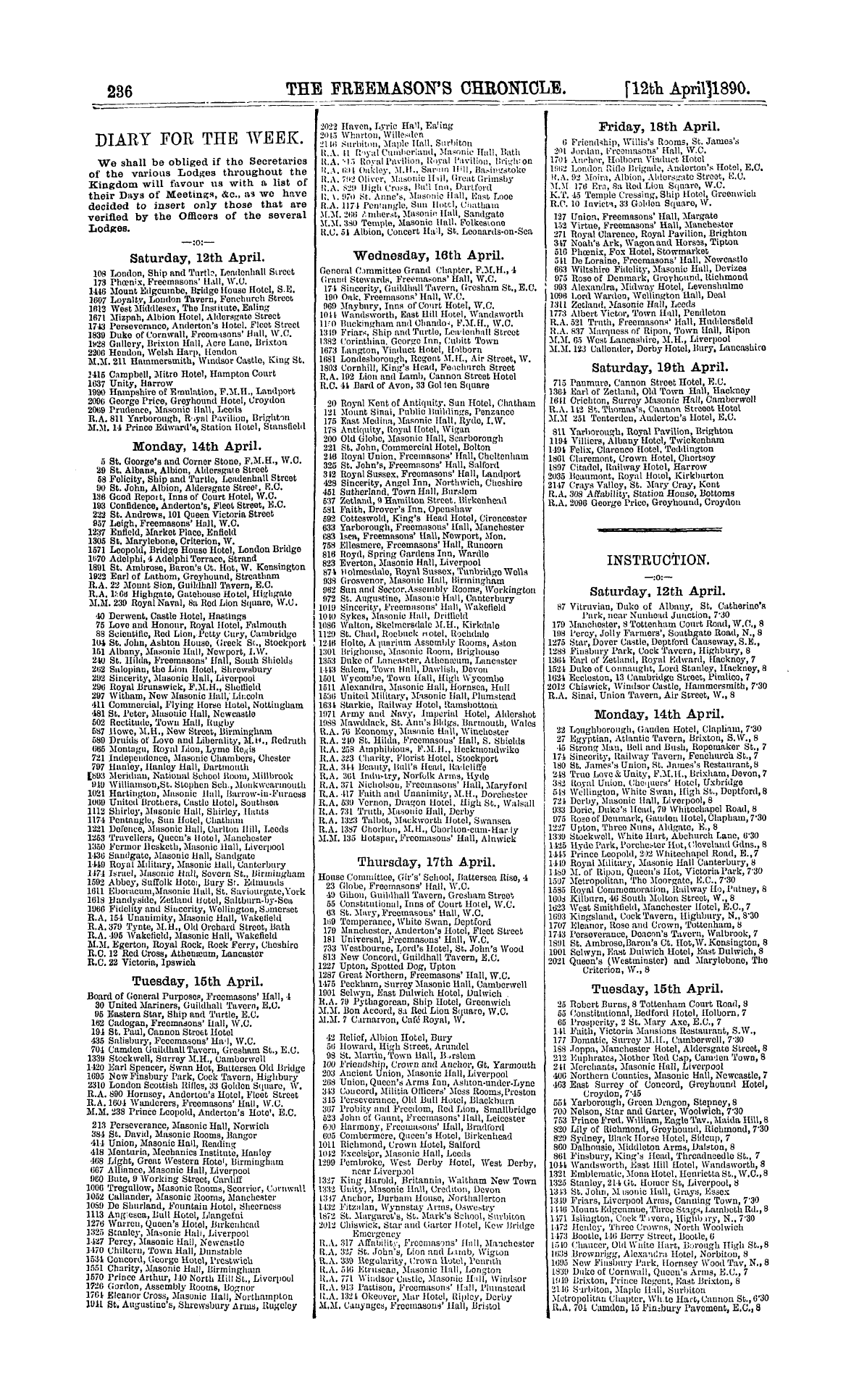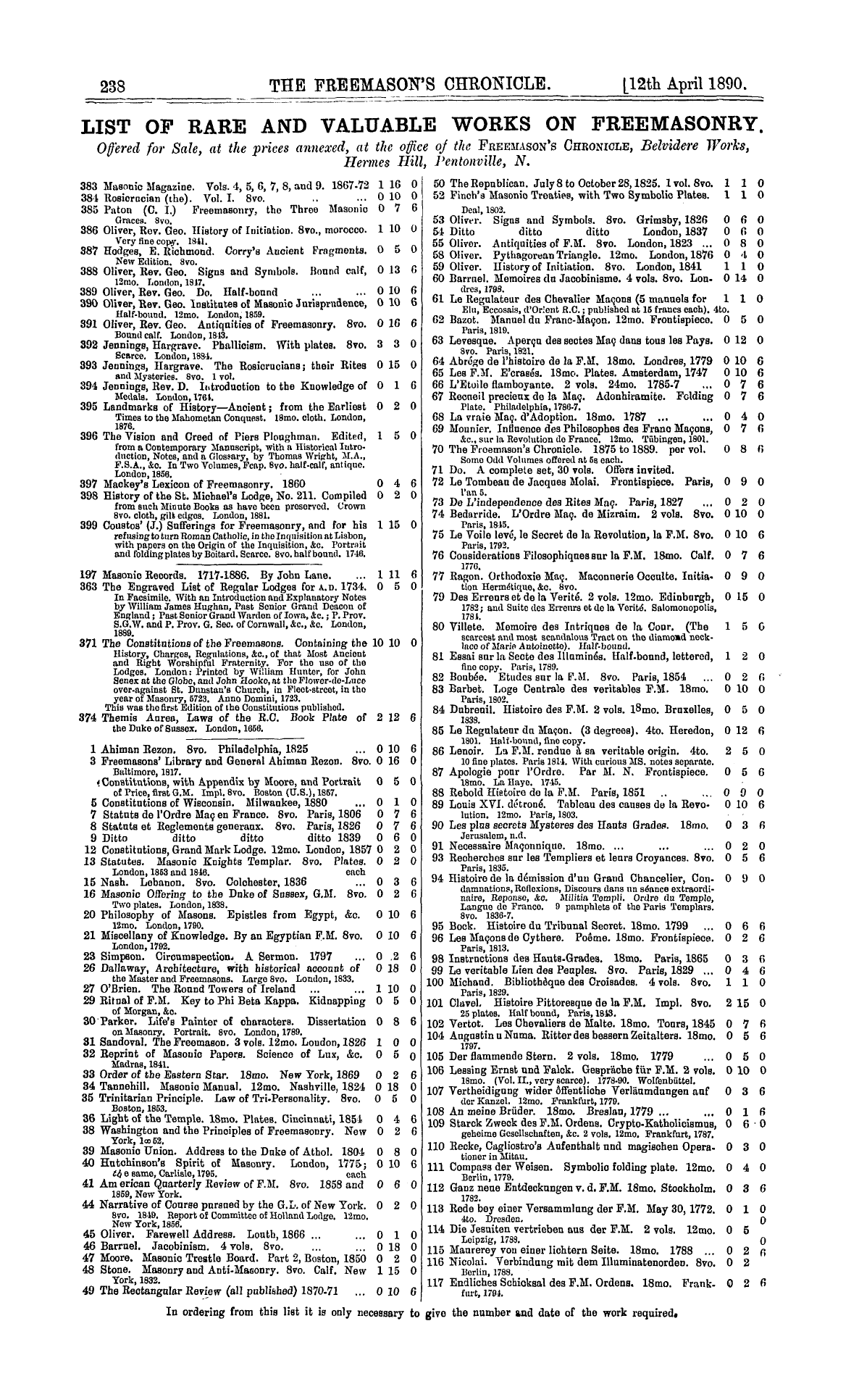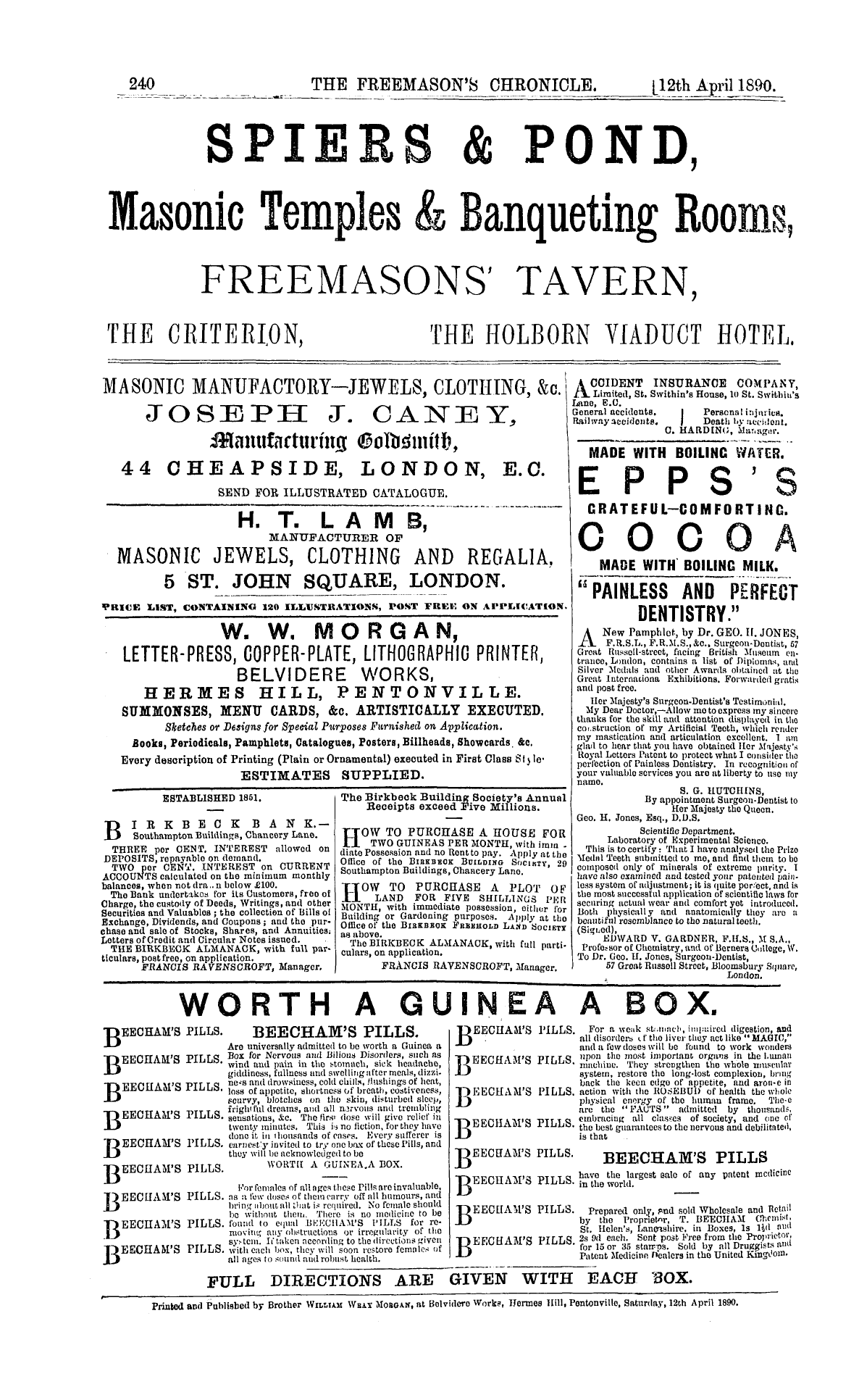-
Articles/Ads
Article NOT SO BAD AS AT FIRST SUPPOSED. Page 1 of 2 Article NOT SO BAD AS AT FIRST SUPPOSED. Page 1 of 2 →
Note: This text has been automatically extracted via Optical Character Recognition (OCR) software.
Not So Bad As At First Supposed.
NOT SO BAD AS AT FIRST SUPPOSED .
Bv Buo . JACOB NOUION . THE Rev . Isaac Taylor , in his attack on tho pious Puseyites , in his work called " Ancient Christianity , " after expressing bis contempt for the pious Rev . Butler ' s Lives of the Saints , goes on to say : —
"Let anyone open Bntler ' a Lives of the Saints afc hazard , and without looking afc dates of tho several lives therein related , let him select a few whioh appear the most ridiculously absurd , or which are on any account pecnlarly offensive , and I will venture to predict that these articles , so distinguished by their extravagance and folly ,
will turn ont to be nicene [ that is , of those who lived in the 3 rd or 4 th century ] , and not to popish stories . In fact they will be found to bo translations from [ the writings of ] Athanasins , Basil , Paladins , Jerome , or some of their contemporaries . On the contrary ,
any lives that may appear to be less objectionable , and in a sense edifying , will be those of modern Romanist saints . If then the lives of the saints as a whole be worthy of contempt , the principal stress of this contempt falls nofc on fche Chnrch of Rome , bufc upon the church of the third and fourth century . "
Our author then goes on to assure us that ridiculous as Butler ' s Lives of those early Saints are , they , comparatively speaking , ' aro highly rational to tho same lives as originally written by the early writers . In short , Butler left out some of the most absurd stories given by
Athanasius , Jerome and Co ., and modified and softened down others . It is evident , therefore , that the greatest pietists believed in the greatest absurdities , and thafc the Romanists to whom Butler belonged were not qnito 88 pious as their predecessors of the Nicene periods were . Hence the Romanists could not believe as much as the
more pious primitive writers believed . By the same rule we may discover the comparative piety of our Masonio writers . Take out , at hazard , a number of contributions to Masonic papers , magazines , and even from the Transactions of tho Q . C . Lodge , and you may depend
upon it that every absurd contribution was written by a pietist , and tho most intense pietist will be found fco have written the most absurd stuff . Thepre-1717 MSS ., as well as the histories and literature of the last century , wero more or less the productions of pietists . Oliver , Mackey , C . "W .
Moore , and numerous other Masonic writers of this century , were pietists , and on reading their respective writings it will bo found that those who invented the greatest number of fibs , or who believed in the most absurd Masonic fables ,
were the most pious . And that our now living pious Masonic writers still continue to write absurdities may be illustrated by contributors to the Masonic press . Thus , not long since , I read an article in the Keystone on " Ancient Landmarks . " If I had not seen the writer ' s name I should
still have been satisfied that it was written by a pietist . Tho same may be illustrated by the absurd semi-annual leaders in the said Keystone about the connection of the Saints John with Masonry . The seventy columns of that paper , during tho last twenty years , which have been
devoted to that subject , are so ridiculously absurd that , in my estimation , Bro . Mac Calla , its editor , deserves the title as one of the very greatest of our American Masonic pietists . About forty years ago , an old Lecturer of the Grand Lodge
of Massachusetts , while alluding contemptuously to some person , said , in my presence , " He understands it no more than Jews understand their oxon Scriptures . " Now , it will be conceded by every sensible man that such an absurdity could only have been uttered by a pietist .
Again , take up the absurdities still retained in some American Masonic rituals , and these are likewise the work of pietists . But that is not all , for it often happens that of a phrase introduced say sixty years ago , or even less , pious brethren will swear that it is an ancient landmark . Thus ,
in 1842 , 1 was assured that the story about Hiram Abiff ' s monument was an ancient tradition , and the late pious Bro . Rob Morris , when I last saw him , in Boston , insisted that it was an ancient tradition . But the truth is , Jeremy L . Cross invented the so-called Hiram Abiff ' s
monument in 1819 . The same Bro . Cross introduced into the ritual in 1819 " The Lion of the Tribe of Judah , " and thia has since then given rise to a phrase , viz ., " thc lion ' s paw , " or " the lion ' s grip . " And a very learned writer has
since then proved that the said phrase descended to us from the mysteries of our ancient Egyptian Masonic brethren . But here is something which Mackey gives , upon authority , as an ancient tradition preserved by English Lodges , viz .: — "From the building of the first Temple afc Jerusalem , fco the
Not So Bad As At First Supposed.
Babylonish captivity , Freemasons' Lodges were dedicated to King Solomon . From thence , to tho coming of tho Hessian , they wero dedicated to Zerubbabel , tho builder of the second Temple ; and from that time , to the final destruction of the Temple by Titus XXX ., they were dedicated to St . John the Baptist ; but owing
to tho many massacres aud disorders which attended that memorable event , Freemasonry sank very much into decay ; many Lodges wero entirely broken up , and but few could meet in sufficient numbers to constitute their legality and at a general meeting of the Craft , held in the city of Benjamin , it was observed that the principal reason for
the decline of Masonry was the want of a Grand Master to patronise it . They therefore deputed seven of their most eminent members to wait upon St . John the Evangelist , who was at that time Bishop at Ephesus , requesting him to take npon himself that office . Ho returned for answer , thafc though well stricken iu years ( being
upwards of ninety ) , yefc having been in tho early part of his life initiated into Masonry , he would tako npon himself thafc office . He thereby completed , by hia learning , what the other St . John had
completed by his zeal , and thus drew what Freemasons terra a line parallel . Ever since whioh Freemasons' Lodges in all Christian countries have been dedicated to both St . John fche Baptist and St . John fche Evangelist . "
The above tissue of lies used to be recited in Boston Lodges in a most solemn manner , adding thereto that the Saints John " were parallels in Christianity as well as in Masonry . " The fact , however is , the above story was not invented before the second decade of this century . The
earliest publication I find that story in is in the works of Krause , printed in Germany in 1820 , or somewhat later . As lato as 1822 , Frederick Dalcho , the then besfc informed Mason in America , was puzzled for a reason why the Saints John were introduced into Masonry ?
That story , therefore , must havo como to America after 1822 . Now , had our Masonic pious writers distinguished themselves by writing moro truths , and by advocating a higher standard of justice than the less pious Masonic
writers , they would indeed have been a credit to Christianity as well as to Masonry . But being as it is , they deserve to bo despised just aa much as Isaac Taylor despised tho writers of the Lives of Saints . ' '
Now , as a rule , New England Protestants do not believe in the efficacy of Saints' patronage , but on the contrary they regard it as a mere Popish superstition ; and as the only reason they can give for their adherence to Saints' patronage is tbe above ridiculous Masonic St . John
story , a story at which every man of common sense must laugh at , it therefore seems to me that their real motive for adhering to that superstition is not piety , but it arises from a deep-seated prejudice against Jews , and an inward love to insult them with impunity . In short , Masonic love in America is a mere farce .
The Massachusetts Grand Lecturer , however , lately informed me that some of the sectarian allusions , including the recital of the ridiculous story about the Saints John , as above given , are no longer heard in Massachusetts Masonic Lodges , and I have even received a ritual for
laying a corner-stone , printed in 1886 , in which the Saints John are uot mentioned . We see now that tho Grand Lodge of Massachusetts has moved onward somewhat , and this is mainly due to the liberality of the late Grand Chaplain , and to the greater liberality of the Grand
Masters for the last twelve years or so . In Rhode Island , however , piety , or the pleasure of insulting Jewish Masons in Masonic Lodges , kept the Grand Lodge at a stand still . A ritual , printed in Rhode Island in 1886 , for laying a corner-stone has in it , " under the patronage of the holy
Saints John , " & c . And the same ritual was reprinted to be used at the laying of a corner stone of a synagogue on the 23 rd of September 1889 . The said ritual was printed in the local papers * the Jewish papers in New York naturally found fault , so did the editor of the FREEMASON '
CHRONICLE , and so did I . Upon further inquiry I was informed by a Hebrew correspondent from Rhode Island , who I understand is not a Mason , and is therefore less
likely to deny an offence committed by Masons than a Jewish Brother Mason might feel disposed to do . And he informed me , by letter , that the printing of the ritual , without expunging the objectionable allusion to the Saints
Note: This text has been automatically extracted via Optical Character Recognition (OCR) software.
Not So Bad As At First Supposed.
NOT SO BAD AS AT FIRST SUPPOSED .
Bv Buo . JACOB NOUION . THE Rev . Isaac Taylor , in his attack on tho pious Puseyites , in his work called " Ancient Christianity , " after expressing bis contempt for the pious Rev . Butler ' s Lives of the Saints , goes on to say : —
"Let anyone open Bntler ' a Lives of the Saints afc hazard , and without looking afc dates of tho several lives therein related , let him select a few whioh appear the most ridiculously absurd , or which are on any account pecnlarly offensive , and I will venture to predict that these articles , so distinguished by their extravagance and folly ,
will turn ont to be nicene [ that is , of those who lived in the 3 rd or 4 th century ] , and not to popish stories . In fact they will be found to bo translations from [ the writings of ] Athanasins , Basil , Paladins , Jerome , or some of their contemporaries . On the contrary ,
any lives that may appear to be less objectionable , and in a sense edifying , will be those of modern Romanist saints . If then the lives of the saints as a whole be worthy of contempt , the principal stress of this contempt falls nofc on fche Chnrch of Rome , bufc upon the church of the third and fourth century . "
Our author then goes on to assure us that ridiculous as Butler ' s Lives of those early Saints are , they , comparatively speaking , ' aro highly rational to tho same lives as originally written by the early writers . In short , Butler left out some of the most absurd stories given by
Athanasius , Jerome and Co ., and modified and softened down others . It is evident , therefore , that the greatest pietists believed in the greatest absurdities , and thafc the Romanists to whom Butler belonged were not qnito 88 pious as their predecessors of the Nicene periods were . Hence the Romanists could not believe as much as the
more pious primitive writers believed . By the same rule we may discover the comparative piety of our Masonio writers . Take out , at hazard , a number of contributions to Masonic papers , magazines , and even from the Transactions of tho Q . C . Lodge , and you may depend
upon it that every absurd contribution was written by a pietist , and tho most intense pietist will be found fco have written the most absurd stuff . Thepre-1717 MSS ., as well as the histories and literature of the last century , wero more or less the productions of pietists . Oliver , Mackey , C . "W .
Moore , and numerous other Masonic writers of this century , were pietists , and on reading their respective writings it will bo found that those who invented the greatest number of fibs , or who believed in the most absurd Masonic fables ,
were the most pious . And that our now living pious Masonic writers still continue to write absurdities may be illustrated by contributors to the Masonic press . Thus , not long since , I read an article in the Keystone on " Ancient Landmarks . " If I had not seen the writer ' s name I should
still have been satisfied that it was written by a pietist . Tho same may be illustrated by the absurd semi-annual leaders in the said Keystone about the connection of the Saints John with Masonry . The seventy columns of that paper , during tho last twenty years , which have been
devoted to that subject , are so ridiculously absurd that , in my estimation , Bro . Mac Calla , its editor , deserves the title as one of the very greatest of our American Masonic pietists . About forty years ago , an old Lecturer of the Grand Lodge
of Massachusetts , while alluding contemptuously to some person , said , in my presence , " He understands it no more than Jews understand their oxon Scriptures . " Now , it will be conceded by every sensible man that such an absurdity could only have been uttered by a pietist .
Again , take up the absurdities still retained in some American Masonic rituals , and these are likewise the work of pietists . But that is not all , for it often happens that of a phrase introduced say sixty years ago , or even less , pious brethren will swear that it is an ancient landmark . Thus ,
in 1842 , 1 was assured that the story about Hiram Abiff ' s monument was an ancient tradition , and the late pious Bro . Rob Morris , when I last saw him , in Boston , insisted that it was an ancient tradition . But the truth is , Jeremy L . Cross invented the so-called Hiram Abiff ' s
monument in 1819 . The same Bro . Cross introduced into the ritual in 1819 " The Lion of the Tribe of Judah , " and thia has since then given rise to a phrase , viz ., " thc lion ' s paw , " or " the lion ' s grip . " And a very learned writer has
since then proved that the said phrase descended to us from the mysteries of our ancient Egyptian Masonic brethren . But here is something which Mackey gives , upon authority , as an ancient tradition preserved by English Lodges , viz .: — "From the building of the first Temple afc Jerusalem , fco the
Not So Bad As At First Supposed.
Babylonish captivity , Freemasons' Lodges were dedicated to King Solomon . From thence , to tho coming of tho Hessian , they wero dedicated to Zerubbabel , tho builder of the second Temple ; and from that time , to the final destruction of the Temple by Titus XXX ., they were dedicated to St . John the Baptist ; but owing
to tho many massacres aud disorders which attended that memorable event , Freemasonry sank very much into decay ; many Lodges wero entirely broken up , and but few could meet in sufficient numbers to constitute their legality and at a general meeting of the Craft , held in the city of Benjamin , it was observed that the principal reason for
the decline of Masonry was the want of a Grand Master to patronise it . They therefore deputed seven of their most eminent members to wait upon St . John the Evangelist , who was at that time Bishop at Ephesus , requesting him to take npon himself that office . Ho returned for answer , thafc though well stricken iu years ( being
upwards of ninety ) , yefc having been in tho early part of his life initiated into Masonry , he would tako npon himself thafc office . He thereby completed , by hia learning , what the other St . John had
completed by his zeal , and thus drew what Freemasons terra a line parallel . Ever since whioh Freemasons' Lodges in all Christian countries have been dedicated to both St . John fche Baptist and St . John fche Evangelist . "
The above tissue of lies used to be recited in Boston Lodges in a most solemn manner , adding thereto that the Saints John " were parallels in Christianity as well as in Masonry . " The fact , however is , the above story was not invented before the second decade of this century . The
earliest publication I find that story in is in the works of Krause , printed in Germany in 1820 , or somewhat later . As lato as 1822 , Frederick Dalcho , the then besfc informed Mason in America , was puzzled for a reason why the Saints John were introduced into Masonry ?
That story , therefore , must havo como to America after 1822 . Now , had our Masonic pious writers distinguished themselves by writing moro truths , and by advocating a higher standard of justice than the less pious Masonic
writers , they would indeed have been a credit to Christianity as well as to Masonry . But being as it is , they deserve to bo despised just aa much as Isaac Taylor despised tho writers of the Lives of Saints . ' '
Now , as a rule , New England Protestants do not believe in the efficacy of Saints' patronage , but on the contrary they regard it as a mere Popish superstition ; and as the only reason they can give for their adherence to Saints' patronage is tbe above ridiculous Masonic St . John
story , a story at which every man of common sense must laugh at , it therefore seems to me that their real motive for adhering to that superstition is not piety , but it arises from a deep-seated prejudice against Jews , and an inward love to insult them with impunity . In short , Masonic love in America is a mere farce .
The Massachusetts Grand Lecturer , however , lately informed me that some of the sectarian allusions , including the recital of the ridiculous story about the Saints John , as above given , are no longer heard in Massachusetts Masonic Lodges , and I have even received a ritual for
laying a corner-stone , printed in 1886 , in which the Saints John are uot mentioned . We see now that tho Grand Lodge of Massachusetts has moved onward somewhat , and this is mainly due to the liberality of the late Grand Chaplain , and to the greater liberality of the Grand
Masters for the last twelve years or so . In Rhode Island , however , piety , or the pleasure of insulting Jewish Masons in Masonic Lodges , kept the Grand Lodge at a stand still . A ritual , printed in Rhode Island in 1886 , for laying a corner-stone has in it , " under the patronage of the holy
Saints John , " & c . And the same ritual was reprinted to be used at the laying of a corner stone of a synagogue on the 23 rd of September 1889 . The said ritual was printed in the local papers * the Jewish papers in New York naturally found fault , so did the editor of the FREEMASON '
CHRONICLE , and so did I . Upon further inquiry I was informed by a Hebrew correspondent from Rhode Island , who I understand is not a Mason , and is therefore less
likely to deny an offence committed by Masons than a Jewish Brother Mason might feel disposed to do . And he informed me , by letter , that the printing of the ritual , without expunging the objectionable allusion to the Saints















